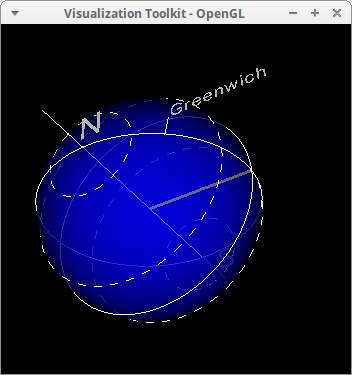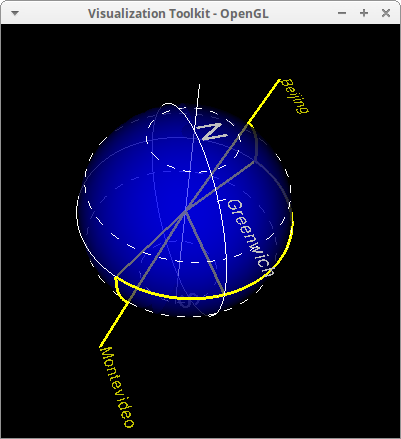Once you have opened a Maxima session, load package draw and then set global variable draw_renderer to vtk:
load("draw") $
draw_renderer: 'vtk $
Explaining latitude and longitude. First, we write function terra:
deg2rad(ang) := float(ang * %pi / 180) $
terra([sitios]) :=
block([G_lat, tropic, polar, place, lat, lon],
tropic: deg2rad(23 + 27/60),
polar: deg2rad(66 + 33/60 + 44/3600),
G_lat: deg2rad(51 + 28/60 + 38/3600),
draw3d(
background_color = black,
axis_3d = false,
color = blue,
opacity = 0.6,
sphere([0,0,0],1),
nticks = 100,
opacity = 1,
color = white,
points_joined = true,
point_type = dot,
points([[0,0,-1.5], [0,0,1.5]]),
/* Greenwich meridian, Equator, Tropics and Polar Circles */
parametric(1.01*cos(t),0,1.01*sin(t),t,0,2*%pi),
parametric(1.01*cos(t),1.01*sin(t),0,t,0,2*%pi),
line_type = dashes,
parametric(1.01*cos(tropic)*cos(t),
1.01*cos(tropic)*sin(t),
sin(tropic),t,0,2*%pi),
parametric(1.01*cos(tropic)*cos(t),
1.01*cos(tropic)*sin(t),
-sin(tropic),t,0,2*%pi),
parametric(1.005*cos(polar)*cos(t),
1.005*cos(polar)*sin(t),
sin(polar),t,0,2*%pi),
parametric(1.005*cos(polar)*cos(t),
1.005*cos(polar)*sin(t),
-sin(polar),t,0,2*%pi),
/* labels */
color = white,
font_size = 0.2,
label(["N", 0, 0, 1.1],
["S", 0, 0, -1.3]),
font_size = 0.1,
label(["Greenwich", cos(G_lat)*1.2, 0, sin(G_lat)*1.2]),
line_width = 1,
line_type = solid,
points([[cos(G_lat)*1.2, 0, sin(G_lat)*1.2],
[cos(G_lat), 0, sin(G_lat)]]),
color = yellow,
line_width = 3,
points([[0,0,0], [1, 0, 0]]),
font_size = 0.1,
/* places */
if length(sitios) > 0
then makelist(
(lat: deg2rad(k[2]),
lon: deg2rad(k[3]),
place: float([cos(lat)*cos(lon),
cos(lat)*sin(lon),
sin(lat)]),
[points([[0,0,0],
[place[1]*1.5, place[2]*1.5, place[3]*1.5]]),
points([[0,0,0],
[place[1], place[2], 0]/sqrt(place[1]^2+place[2]^2)]),
parametric(1.01*cos(t)*cos(lon),
1.01*cos(t)*sin(lon),
1.01*sin(t),
t,min(0,lat), max(0,lat)),
parametric(1.01*cos(t),
1.01*sin(t),
0,
t,min(0,lon), max(0,lon)),
label([k[1], place[1]*1.5, place[2]*1.5, place[3]*1.5])]),
k, sitios)
else []))$
Let's call the function without arguments:
terra() $

Now, we define some geographic locations and draw their coordinates:
Beijing: ["Beijing", 39 + 54/60, 116 + 23/60] $ Montevideo: ["Montevideo", -34-53/60, -56-11/60] $ terra(Beijing, Montevideo) $

© 2016, TecnoStats.